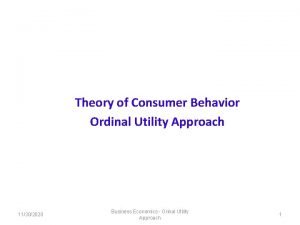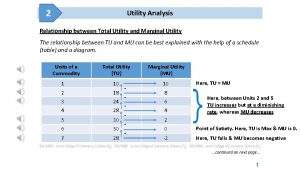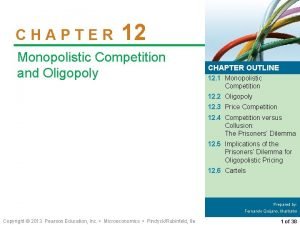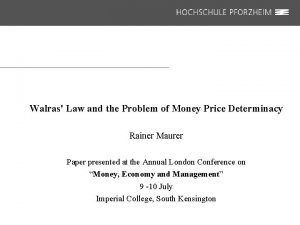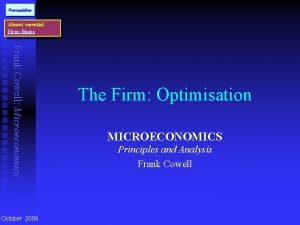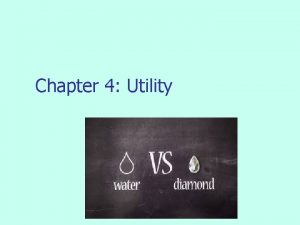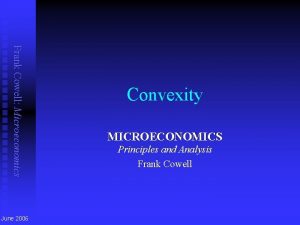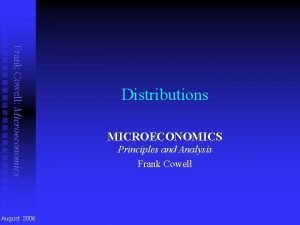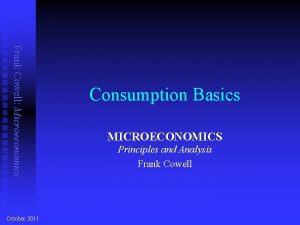Utility Microeconomics What is Marketing Principles of Marketing



















- Slides: 19

Utility Microeconomics What is Marketing? Principles of Marketing

Total and Marginal Utility • Utility is a person’s level of satisfaction or happiness with his or her choices • Total utility is satisfaction derived from consumer choices • Marginal utility is the additional utility provided by one additional unit of consumption • Utility is measured in utils

Budget Constraint Line A budget constraint line shows the possible combinations of two goods that are affordable given a consumer’s limited income

Calculating Marginal Utility MU=change in total utility/change in quantity marginal utility per dollar = marginal utility/price Marginal utility per dollar helps people compare a wide range of purchases and make choices

Law of Diminishing Marginal Utility The law of diminishing marginal utility holds that the additional utility decreases with each unit added

Calculating Total Utility Table 6. 3. Finding the Choice with the Highest Utility Point T-Shirts Movies Total Utility P 4 0 81 + 0 = 81 Q 3 2 63 + 31 = 94 R 2 4 43 + 58 = 101 S 1 6 22 + 81 = 103 T 0 8 0 + 100 = 100

Steps to Calculate Total Utility • Step 1. Observe that, at point Q (for example), José consumes three T-shirts and two movies. • Step 2. Look at Table 6. 2. You can see from the fourth row/second column that three T-shirts are worth 63 utils. Similarly, the second row/fifth column shows that two movies are worth 31 utils. • Step 3. From this information, you can calculate that point Q has a total utility of 94 (63 + 31). • Step 4. You can repeat the same calculations for each point on Table 6. 3, in which the total utility numbers are shown in the last column.

A Step-by-Step Approach to Maximizing Utility Try Choice Which Has 1: P 4 T-shirts and 0 movies 2: Q 3 T-shirts and 2 movies 3: R 2 T-shirts and 4 movies 4: S 1 T-shirt and 6 movies 5: T 0 T-shirts and 8 movies Total Utility 81 from 4 Tshirts + 0 from 0 movies = 81 63 from 3 Tshirts + 31 from 0 movies = 94 43 from 2 Tshirts + 58 from 4 movies = 101 Marginal Gain and Loss of Utility, Compared with Previous Choice Conclusion – – Loss of 18 from 1 less T-shirt, but gain of 31 from 2 more movies, for a net utility gain of 13 Loss of 20 from 1 less T-shirt, but gain of 27 from two more movies for a net utility gain of 7 Loss of 21 from 1 less T-shirt, 22 from 1 Tbut gain of 23 from two more shirt + 81 from movies, for a net utility gain of 6 movies = 103 2 0 from 0 TLoss of 22 from 1 less T-shirt, shirts + 100 but gain of 19 from two more from 8 movies, for a net utility loss of = 100 3 Q is preferred over P R is preferred over Q S is preferred over R S is preferred over T

Choices are Made at the Margin A choice at the margin is a decision to do a little more or a little less of something

The Utility Maximizing Rule •

Consumer Equilibrium Consumer equilibrium is when the ratio of the prices of goods is equal to the ratio of the marginal utilities (point at which the consumer can get the most satisfaction)

Foundations of Demand Curves Changes in the price of a good lead the budget constraint to shift. A shift in the budget constraint means that when individuals are seeking their highest utility, the quantity that is demanded of that good will change

How a Change in Income Affects Consumption Choices A choice like N will be made if both goods are normal goods. If overnight stays is an inferior good, a choice like P will be made. If concert tickets are an inferior good, a choice like Q will be made.

How a Change in Price Affects Consumption Choices The original utility-maximizing choice is M. When the price rises, the budget constraint shifts in to the left. The new possible choices would be fewer baseball bats and more cameras, like point H, or less of both goods, as at point J. Choice K would mean that the higher price of bats led to exactly the same quantity of bats being consumed, but fewer cameras.

Practice Question Explain what choice the consumer is making at point L and why this choice is unlikely.

Consequences of a Price Increase The typical response to higher prices is that a person chooses to consume less of the product with the higher price. This happens for two related reasons: • The substitution effect occurs when a price changes and consumers have an incentive to consume less of the good with a relatively higher price and more of the good with a relatively lower price • The income effect is that a higher price means, in effect, the buying power of income has been reduced (even though actual income has not changed), which leads to buying less of the good (when the good is normal) A higher price typically causes reduced consumption of the good in question, but it can affect the consumption of other goods as well.

Behavioral Economics Behavioral economics a branch of economics that seeks to enrich the understanding of decision-making by integrating the insights of psychology and by investigating how given dollar amounts can mean different things to individuals depending on the situation

Insights from Behavioral Economics • Loss aversion • Nudges help people avoid temptation • Opt-outs work better to encourage behavior like retirement savings since the default is the rational choice • mental accounting, or putting dollars in different mental categories where they take different values

Quick Review • What are utility and satisfaction? • How do consumers maximize total utility within a given income using the Utility Maximizing Rule? • How does consumer’s utility change when income or prices change? • What is the behavioral economics approach to understanding decision making?
 22rents
22rents Ordinal and cardinal utility
Ordinal and cardinal utility Relation between marginal utility and total utility
Relation between marginal utility and total utility What is microeconomics
What is microeconomics Example of microeconomics
Example of microeconomics What is the subject matter of microeconomics
What is the subject matter of microeconomics Why is microeconomics important
Why is microeconomics important Intermediate microeconomics lecture notes
Intermediate microeconomics lecture notes Intermediate microeconomics notes
Intermediate microeconomics notes Cartel microeconomics
Cartel microeconomics Walras's law
Walras's law Externalities and public goods microeconomics
Externalities and public goods microeconomics Frank cowell microeconomics solutions
Frank cowell microeconomics solutions Macroeconomics michael parkin 13th edition
Macroeconomics michael parkin 13th edition Definition of macroeconomics
Definition of macroeconomics Objectives of microeconomics
Objectives of microeconomics Microeconomics
Microeconomics Microeconomics
Microeconomics Uses of microeconomics
Uses of microeconomics Microeconomics examples
Microeconomics examples

